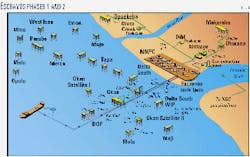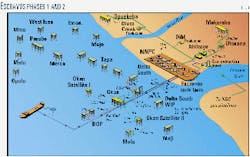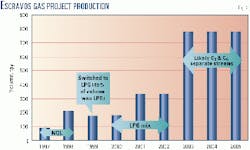The Escravos gas project, a joint venture of Nigeria National Petroleum Corp. (60%; NNPC) and Chevron Nigeria Ltd. (40%), has moved nearer its twin goals of reducing the country's gas flaring and finding commercial outlets for the country's huge natural gas reserves.
As originally envisioned, the project consisted of three phases that spanned 1997-2005. Phase 1 started up in 1997; Phase 2 will start up before yearend, and Phase 3 targets 2005.
Fig. 1 presents the layout for Phases 1 and 2.
In an added twist to the project, the joint-venture partners announced in early September an addition to Phase 3: installation of a gas-to-liquids (GTL) plant that will be able to produce and ship into international markets as much as 33,000 b/d of clean liquids from natural gas fed from the Phase 3 gas-plant expansion.
The partners are investing a total of $2 billion in Phase 3 and the GTL plant.
Phases; production
Femi Odumabo, Chevron Nigeria Ltd.'s manager for production operations support, told attendees of Purvin & Gertz' International LPG Seminar earlier this year, that Phase 1 can process 185 MMscfd of gas from offshore fields and produce 8,500 b/d NGL or 7,000 b/d LPG.
Chevron has said elsewhere Phase 1 produces 130 MMcfd of residue (dry) gas (OGJ Online, July 21, 2000).
Phase 1 started with the production of NGL, said Odumabo, but switched in June 1999 to LPG production to improve netback, expand market base, and enhance FOB sales.
LPG mix has a wider market than NGL because of the presence of C5+ and the need to fractionate it. Fig. 2 presents NNPC's NGL production history and its LPG production forecast.
The joint venture also prefers FOB sales, he said. In early 2000, Chevron Nigeria sent tenders out to both international and Nigerian (local) markets for sales of Escravos LPG production beyond Phase 1.
The response to the tender was excellent, Odumabo said, leading Chevron to anticipate the joint venture would be able to sell future LPG production for the period extending to Dec. 31, 2001, on FOB basis and with better netback.
The potential markets for Escravos LPG are Brazil, Ecuador via Panama Canal, Northwest Europe, China, countries of the Eastern Caribbean, and the US Gulf of Mexico, among others.
Odumabo said that Nigeria is a gas province with some crude oil in it. Non-associated gas reserves are huge, with total combined gas reserves of 120 tcf estimated to last for the next 100 years.
Oil reserves, by comparison, are likely to last only about 30 years at current production rates, he said. On the average, about 1 Mscf of gas is produced with every barrel of oil in Nigeria.
Therefore, about 2 bcfd of associated gas are produced with nearly 2 million bbl of oil. Flared gas soaks up more than 70% of this quantity. "Flaring of this huge quantity of gas is a waste of a vital national resource," said Odumabo.
The Nigerian government therefore resolved to eliminate all gas flares by 2010, except for those required for safety. This governmental position is fueling the production of more gas liquids, particularly LPG.
He added that another important benefit of the project has been the replacement of fuel oil in the country's industries with clean, dry gas "at costs below the equivalent for fuel oil."
Phase 2 focuses on improving the environmental conditions in the swamp fields through the reduction of oil-associated gas flaring. In more recent comments to Oil & Gas Journal, Odumabo said gas-gathering systems are being installed in the Abiteye and Olero Creek areas.
Phase 2 will add 100 MMscfd of capacity, bringing total Escravos gas-processing capacity to 285 MMcfd.
Odumabo estimated combined production from Phases 1 and 2 at 10,200 b/d (or 870 tonnes/day, tpd) of LPG, or approximately 320,000 tonnes/year (tpy).
Phase 3 will more than double capacity, adding another 400 MMcfd and extracting about 15,000 b/d of NGL.
Additionally, the new Phase 3 plant will send up to 300 MMscfd of natural gas to the Escravos GTL plant, which will produce approximately 33,000 b/d.
That latest aspect of the overall project will utilize the combined technologies of Sasol Ltd.'s Fischer-Tropsch process with Chevron Corp.'s hydroprocessing expertise.
Shipping
Escravos gas project LPG is stored aboard a floating storage and offloading vessel (FSO) some 32 km offshore Escravos. It supplies refrigerated LPG to the export vessels and has a capacity of 54,000 cu m (340,000 bbl).
As of the beginning of 2000, said Odumabo, approximately 400,000 tonnes of NGL and 100 tonnes of LPG had been exported from Escravos' FSO.
It is the world's first purpose-built LPG storage vessel, fabricated from steel and designed for 20 years of uninterrupted service. It also uses a single-point mooring system.
Off-take is by tandem loading, said Odumabo, which makes the supply-to-export vessels unique because not all LPG ships are equipped for tandem loading.
Therefore, most ships would need some form of modification to be able to load from the FSO. These modifications, however, are not major, he said.



